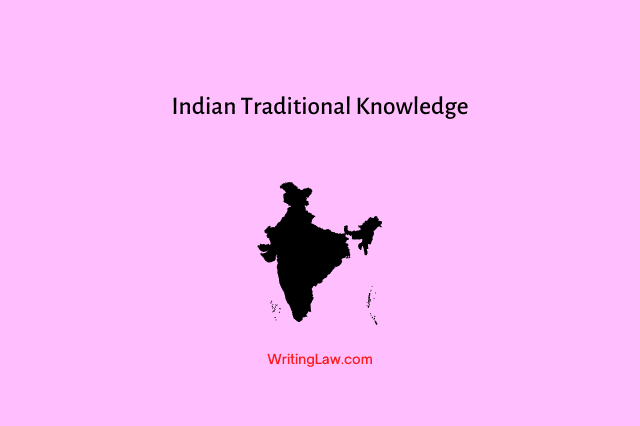
In a diverse and culturally rich country like India, traditional knowledge is a significant asset to the country. Hence, there is a need to claim intellectual property rights (IPR) for this asset to prevent it from being misappropriated by other nations. This law article tells you about claiming intellectual property rights for India’s traditional knowledge.
- Indian Traditional Knowledge – an Introduction
- Intellectual Property Rights and Traditional Knowledge
- IP Protection for Traditional Knowledge in India
- Conventions on Traditional Knowledge
- Legislations for the Protection of Traditional Knowledge
- TKDL (Traditional Knowledge Digital Library)
- TKRC (Traditional Knowledge Resource Classification)
- Case Studies Illustrating the Necessity of IPR for Traditional Knowledge
- Conclusion
Indian Traditional Knowledge – an Introduction
Traditional knowledge, as the name indicates, is the body of indigenous practices especially relating to medicine, agriculture, etc., that has been passed down through generations.
The World Intellectual Property Organisation (WIPO) defines it as “knowledge, know-how, skills, and practices that are developed, sustained, and passed on from generation to generation within a community, often forming part of its cultural or spiritual identity.”
Traditional knowledge has great significance in scientific developments taking place in the contemporary world. For instance, several medicines of Ayurveda, like turmeric, Ashwagandha, etc., are packaged and sold in US and European markets. If India was able to patent the traditional knowledge relating to these medicinal plants, then the country and the indigenous people benefit tremendously. Also, this would prevent the exploitation and commercialisation of traditional knowledge without consulting the stakeholders and bearers of such knowledge.
There have been several cases where the West has tried to claim patents for Indian traditional knowledge, and the nation had to fight long legal battles against it. However, it is high time that India takes some proactive measures rather than just reactive ones to protect its vast traditional knowledge.
Intellectual Property Rights and Traditional Knowledge
Intellectual property rights (IPR) are the rights conferred upon the creators of an idea to use it exclusively and to prevent others from replicating it. It is an intangible asset of great importance in the current era.
IPR usually includes patents, copyrights, trademarks, and trade secrets.
The idea of IPR for traditional knowledge was first raised in the Convention for Biological Diversity (CBD). Article 8(j) of the convention states that all member countries have to enact a law to protect traditional knowledge and innovations. The law has to ensure that there is an equitable sharing of benefits to indigenous people when traditional knowledge is used for commercial purposes. Such commercial use should always happen with the consent of all stakeholders. This can only be done when the indigenous community has IP rights over their traditional knowledge.
The World Intellectual Property Organisation (WIPO) has time and again recommended a sui generis (of its own kind, unique) system for ensuring IP rights for traditional knowledge. The organization has published a comprehensive booklet on the traditional knowledge that has been granted IP rights so far. This includes trademarks for potatoes in Peru and Taita baskets in Kenya, copyrights for ethnic fabric designs in Ghana, etc. IPR for traditional knowledge covers both traditional skills and know-how as well as cultural expression (dances, rituals, practices).
IP Protection for Traditional Knowledge in India
India is still taking baby steps to ensure intellectual property rights for traditional knowledge. It is a signatory to several conventions on the protection of traditional knowledge, and some provisions in the IP laws of India address this issue. The country has also constituted a database and classification system to document traditional knowledge for IP purposes.
Conventions on Traditional Knowledge
Even before municipal laws were evolved regarding IP protection for traditional knowledge, there were several conventions in the international arena advocating for such protection. Some important conventions are mentioned below.
Convention on Biological Diversity
Article 8(j) of the Convention for Biological Diversity deals with maintaining and preserving traditional knowledge and techniques with due cooperation from its holders. It also talks about evolving a method of equitable benefit sharing of the products of traditional knowledge.
On the other hand, Article 10(c) deals with the allocation of biological resources for traditional processing and techniques.
Article 15(5) states that traditional knowledge relating to genetic resources can only be used with the consent of the communities involved.
Article 17 relates to the exchange of information regarding traditional knowledge, and Article 18(4) makes it obligatory for member states to take measures to protect traditional knowledge.
Nagoya Protocol, 2010
The protocol is essentially a widening of the Convention on Biological Diversity. India ratified the protocol in 2012. It elaborates on equitable benefit sharing for traditional communities when there is commercial utilization of traditional knowledge.
The International Treaty on Plant Genetic Resources for Food and Agriculture
This is also known as the seed treaty and deals with the protection of traditional knowledge relating to agricultural produce. Article 9(2)(a) of the treaty provides for the preservation of traditional knowledge relating to plant genetic resources, while Article 9(2)(b) deals with equitable benefit sharing.
TRIPS Agreement (Agreement on Trade-Related Aspects of Intellectual Property Rights)
Article 1 of the agreement allows member nations to provide any level of extended IP protection as the country deems fit. This allows all nations to formulate measures for the extended protection of traditional knowledge.
United Nations Conference on Protection of Trade and Development (UNCTAD)
This conference has created a global forum for discussions on traditional knowledge and also made significant recommendations on its protection.
Legislations for the Protection of Traditional Knowledge
India has no specific laws for protecting traditional knowledge, but the existing IP laws have some provisions relating to it.
Patent Act of 1970
Section 25 and 64 of the Act deals with the revocation of patents based on traditional knowledge.
Copyrights Act of 1957
Section 31A of the Act states that copyright may be granted to any unpublished work. This might also include traditional knowledge. However, copyright is only a temporary protection and is not of much use if granted to traditional knowledge that lasts for eternity.
TKDL (Traditional Knowledge Digital Library)
The TKDL is an Indian digital repository of traditional knowledge. It contains almost 34 million pages of documented traditional knowledge. It is available in English, German, French, Japanese, and Spanish.
TKDL was a collaborative project by the Council of Scientific and Industrial Research (CSIR); the Ministry of Science and Technology; the Department of Ayurveda, Yoga and Naturopathy, Unani, Siddha, and Homeopathy (AYUSH); and the Ministry of Health and Family Welfare. It is headed by the CSIR.
The objectives of constituting such a database are to provide information to patent granting offices and to prevent the misappropriation of traditional Indian knowledge. Several patent offices, like the European Patent Office, the Indian Patent Office, the German Patent Office (October 2009), the United States Patent and Trademark Office, the United Kingdom Intellectual Property Office, the Canadian Intellectual Property Office, and IP Australia, have access to this digital library.
TKRC (Traditional Knowledge Resource Classification)
The TKRC is a system of classification linked to the International Patent Classification (IPC) system. It is specifically for Indian medicine and Unani products. It systematically classifies plants and the medicines derived from them through certain codes. This allows for a catalogue of traditional knowledge related to medicine.
Case Studies Illustrating the Necessity of IPR for Traditional Knowledge
These case studies explain how easily foreign companies claimed IP rights over Indian traditional knowledge while the parent country remained in ignorance. It also describes the long-drawn legal battles that the country had to fight to reclaim its traditional knowledge resource. It is a brief analysis of how it is better to be proactive rather than reactive when it comes to protecting your resources.
Patent for Healing Properties of Turmeric
Suman K Das and Hari Har P Cohly, two Indian American scientists of the University of Mississippi Medical Centre, filed for a patent for the healing properties of turmeric. They were claiming that they had discovered the healing properties of the plant when it has been common knowledge in India for time immemorial. In an absurd turn of events, they were granted patent rights by the US Trade and Patents Office in March 1995. Finally, the CSIR had to apply for re-examination, and the patent was revoked.
Patent for Using Neem Oil as a Fungicide
Indian farmers have been using neem oil as a natural fungicide and pesticide for ages. However, W.R. Grace and the Department of Agriculture, USA, filed a patent for a neem oil-derived pesticide in the European Patent Office. A grace patent was granted for it.
According to the US code, a grace patent may be accorded for anything that is modified from a natural product. Foreign knowledge is not adequate to revoke a grace patent unless it is published.
Hence, the legal representation by the New Delhi-based Research Foundation for Science, Technology and Ecology (RFSTE), in cooperation with the International Federation of Organic Agriculture Movements (IFOAM) and Magda Aelvoet, former green Member of the European Parliament (MEP), was not accepted.
This led to a great hue and cry among Indian agriculturalists and researchers led by Dr. Shiva. Following the incessant protests, the patent was revoked, and the appeal filed against the revocation was dismissed.
Patent for Basmathi Rice
An American company, Rice Tec, received a patent for 15 varieties of aromatic Basmathi rice from the US Patent and Trade Office. This was contested by India in a three-year legal battle. Finally, the patent was revoked.
Conclusion
The World Intellectual Property Organisation (WIPO) states that a country must take both positive as well as defensive measures to safeguard its traditional knowledge. India has taken a lot of positive measures, but it lacks in its defensive measures.
The former Justice Vijendar Jain, in his speech at the Asia Pacific Jurist Association, has recommended a sui generis (of its own kind, unique) law as a defensive mechanism to safeguard traditional knowledge. The reasons for a sui generis law are as follows:
- Traditional knowledge is usually unpublished, and hence granting copyrights to it under the existing laws is difficult. Moreover, copyright is temporary.
- Copyrights, trademarks, and patents are usually granted to individuals and entities, but traditional knowledge is usually collectively owned.
- Existing IP laws allow for modifications or innovations on the protected idea. Such a modification is not IPR infringement. However, much extensive protection should be granted to traditional knowledge.
Considering all this, a separate law to claim intellectual property rights for traditional knowledge is the need of the hour.
Read Next: Does India Have a Legitimate Claim to Bring Back the Kohinoor Diamond?








